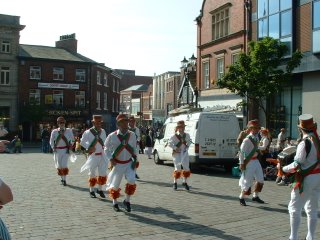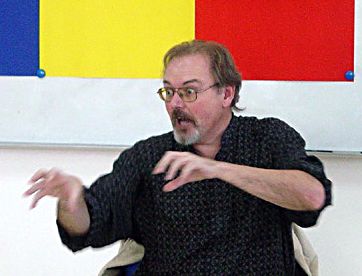 The trouble with England is it attempts to revive long dead traditions, like good beer and folk dancing.
The trouble with England is it attempts to revive long dead traditions, like good beer and folk dancing.To have experienced the real folk 'life' of a village hidden away in the foothills of Transilvania is to have seen a glimpse of what lies behind the "stick-your-finger-in-your-ear, drink-Camra-approved-beer-only, strap-bells-on-and-prance," folk revivals of modern day England.
Don't get me wrong, I'm not saying there is anything wrong with these revivalists (there is, but I'm not saying it - I am sure it keeps a lot of very dodgy characters off the street - or rather on the street but highly visible in white outfits waving red handkerchiefs about): But the one thing they are trying to revive, tradition, is the one thing that is dead.
You can't revive the dead. Reserection is not the same as revival.
Real folk dance has survived, and is doing well, in many places in Eastern Europe and the Balkans.
It is the dance of the 'volk' - folk who live there: Ordinary, everyday folk - people who have lived in the village or town all their life, who's great-grandparents did the similar dances and sang similar songs, and their great grandparents did the same - not always in this village or town, but close-by, or if not close by, they carried similar traditions from longer distances and understood, when they moved here, what doing the local dances meant and quickly "assimilated".
They have been more or less unaffected by urbanisation - and mechanisation, and industrialisation.
Until the last 20 years or so (still, in many places), fields were ploughed behind a horse or ox, or dug by hand. The tractors of communism had little influence outside the communes: Fields are too small, people too old,money too tight.
Most farming is subsistence. Nationally of little importance for the GDP and so ignored - until you realise just how many older people are involved, and how many of their children and grandchildren get part of their food and a lot of their alcohol from the smallholdings.
Electricity has come recently too - great for cutting the wood you still fuel the cooker with, and put in the stove you heat your mud-brick or wooden house in winter with. Electric light too - but most people are in bed by 10 o'clock at night and up with the cows, which they milk by hand.
If you had a television - and you would be suprised how recently T.V. has come to many places, it was black and white, full of state propaganda - or folk music and dances.
Many places still have no cell-phone signal - including, thankfully, my house in Romania.
Folk music and dance is a way people have found to entertain themselves. It concerns their very real lives, and celebrates their concerns, needs, wishes.
It is sung when they harvest the crops - setting up a rhythm that helps make the tedium and back-braking work pass. The same songs are sung again at weddings.
This is not the lushly filmed, pretty picture BBC 'Historically-almost-right', glorious summer-afternoon, nostalgic, dramatisation of a 19th Century novel (written long after the coming of industry and machines); it is dirty, smelly, strong armed men and women getting in the harvest before the weather changes and ruins the hay, or the birds take too much of the crop.
They sing for inspiration and endurance.
When they dance, it is a celebration of community.
Young men dance together - male bonding long before the business psychologists got hold of it. The village/family needed people to co-operate with and trust one another. A ring dance, such as the Romanian Hora, requires concentration and co-ordination, enthusiasm and energy - all skills needed by the community if it was to thrive.
And that hora is still danced - in the strangest of places: My first encounter of the dance was at an 18th birthday party, when someone, in the middle of the loud, modern disco, put on a tape of traditional music, and up the 'boys' got, almost to a man, and danced the hora: Arm across shoulders, attention to the steps.
Young, frequently unmarried, women dance together too. Different dances - female bonding (why don't we hear of that as frequently as male bonding?). After all, the village women co-operate as much as the men.
And then there is the music making.
Again, it is local people who make the music - yes, there are (increasingly) specialists, but much of the original music was provided by local people who worked the day in the fields, just as everyone else did. They worked with old tunes rather than composed new; they were preservers and passers on, not in a stick it in the museum kind of way, but in, this is what is expected, this is what I will do - after all, we are here to enjoy ourselves, and help others do the same - kind of way.
I hear talk of modern 'pop' music being the contemporary folk - which is to miss the community generated, self owned, never the same twice, point. Music had to be "made" again and again - never recorded for re-use.
And it is a group activity. Musicians work together: Musicians work with the dancers: Dancers and Musicians work with the community, who sing along, join in, shout, laugh - together giving meaning to the activity.
Even when people go to watch a staged performance at a festival, that sense of joint ownership is still there. And the sense that this music captures something essential from the life of the people watching.
When I used to sing, 'John Barleycorn', it was a good tune, fun to sing: Since living a semi-self-sufficient existence, where what I grow is what I eat and drink, it means more - if I were part of the English community which ate and drank bread and beer made from its own grown barley, whose ancestors first coined the song, it would mean even more.
(To be continued?)

No comments:
Post a Comment